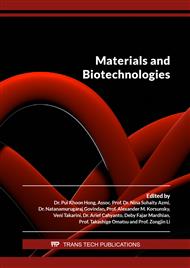p.111
p.121
p.129
p.135
p.145
p.153
p.161
p.167
p.177
Tensile Strength and Shore Hardness Evaluation in Clean Grade Silicone with Nanosilica Filler Reinforcement as an Alternative for Maxillofacial Prosthesis Materials
Abstract:
Maxillofacial prostheses are usually replaced periodically due to poor tear strength at the edges, inelasticity, and excessive hardness. Improvement in mechanical properties can be achieved by adding nanosilica fillers. Medical grade silicone as a maxillofacial prosthesis material is difficult to find on the local market and is quite expensive. Therefore, it is necessary to have an alternative maxillofacial prosthesis material that is more affordable and accessible. Clean grade silicone is a non-toxic type of silicone that can be modified by adding nanosilica filler to have properties similar to medical silicones so that they can be accepted as an alternative to maxillofacial prosthesis materials. The samples were made from clean grade silicone with various addition of nanosilica fillers: 0% (control), 1%, 2%, 3%, and 6%. Tensile strength was tested on each sample according to ISO 37: 2017 for silicone rubber. Dumb-bell shape samples were tested on Llyod Universal Testing Machine with 500 mm/min transverse rates. Hardness was tested on each sample according to the ASTM D2240 for silicone rubber. Six indentations were carried out on a rectangle sample (36 x 60 x 6 mm) tested with Durometer type A. The hardness result increased from 15,7 to 42,8 Shore A, while tensile strength decreased from 3.38 to 2.14 MPa. This could happen due to the agglomeration of silica filler concentration and need further research on the ratio and method for mixing. So, it can be concluded that the addition of 3% nanosilica filler resulted in acceptable tensile strength and hardness value as a substitute for maxillofacial prosthesis material.
Info:
Periodical:
Pages:
145-152
Citation:
Online since:
August 2022
Authors:
Price:
Сopyright:
© 2022 Trans Tech Publications Ltd. All Rights Reserved
Share:
Citation:



